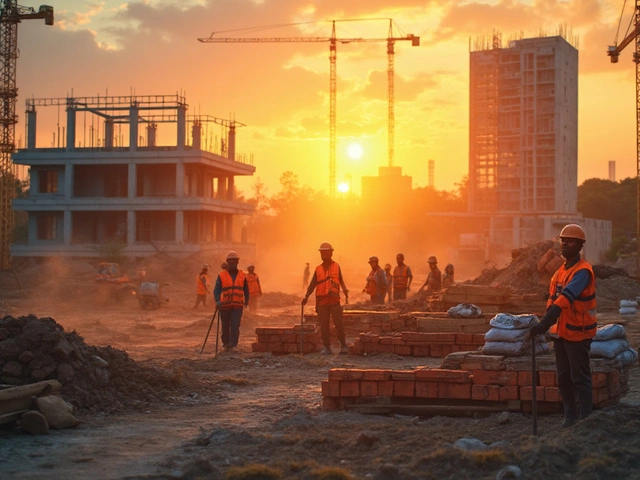Is a House Extension Worth It? Real Costs, Value, and Hidden Benefits Explained
It’s wild how quickly a home can start to feel cramped. Maybe your family’s growing, maybe you dream of a giant kitchen, or maybe you finally want that sun-soaked art studio. But with moving costs soaring and property prices rising faster than weeds in spring, you might start wondering, “Is a house extension worth it?” You’re not alone. The past five years have seen a 30% jump in UK planning applications for extensions, and in the US, permits have skyrocketed since 2020 as people rethink their spaces. But money’s not the only thing at stake—there’s the mess, the decisions, and the what-ifs. Before you start knocking down walls, make sure you know what you’re signing up for. Surprisingly, it’s not always about square footage or resale value (although those matter). Stick around as we dig deep into the facts, frustrations, and secrets behind house extensions and their real worth.
Cost Breakdown: The Real Price Tag of Extending Your Home
Let’s get straight to the elephant in the room: the price. Nobody dreams about blueprints and tile samples until those numbers start adding up. The national average cost for a single-storey extension in the UK sits around £2,000 per square meter, but prices spike to £3,500 depending on location and quality. In the US, you’re talking $90 to $210 per square foot, and that’s before you flirt with marble countertops or bi-fold glass doors. Big cities? Add at least 20% for labor.
Here’s where budgets go sideways. People tend to forget site prep, plumbing, and rewiring. Bathrooms pile on the expense—moving a toilet can cost ten times more than moving a wall. And if you live in an old Victorian or pre-war house, brace yourself for surprises behind the plaster. In a real survey from Homebuilding & Renovating magazine in 2024, 61% of UK homeowners reported surprise costs after work started, with structural repairs and delays adding thousands.
Don’t just pencil in the builder’s quote. You’ll need to factor in:
- Architect and engineering fees (often 10-15% of build cost)
- Planning permission and council fees (£200-£1,500 or more if you tweak plans)
- VAT at 20% in the UK (yes, even on the builder’s labor)
- Temporary accommodation if the build’s too messy
- Upgrades to heating, wiring, or insulation to meet code
- Waste disposal—skips and landfill fees aren’t cheap
If you’re budgeting to the pound or the dollar, add a 15% emergency pot. Nearly every seasoned renovator I know (including Elena and myself) landed somewhere above their initial spend, even with careful planning. For bigger builds—think basement conversions or two-storey additions—costs climb sharply. Here’s a table showing just how these figures break down on average across different types of extensions, based on real 2024 and 2025 UK/US data:
| Type of Extension | Average Size | UK Cost Range | US Cost Range |
|---|---|---|---|
| Single-Storey Rear Extension | 25 sqm/270 sqft | £50,000 - £87,500 | $24,000 - $56,700 |
| Double-Storey Side Extension | 50 sqm/540 sqft | £100,000 - £175,000 | $48,000 - $120,000 |
| Loft Conversion | 20 sqm/215 sqft | £40,000 - £68,000 | $18,000 - $45,000 |
| Basement Conversion | 30 sqm/320 sqft | £100,000 - £180,000 | $65,000 - $100,000 |
This isn’t counting extras like underfloor heating or sliding garden walls. Prices in London boroughs or San Francisco are sometimes double the national average, so always research your local rates.
Value Added: What Extensions Really Do for Your Home’s Worth
Mention a house extension at a dinner party and someone’s bound to say, “You’ll make it all back when you sell.” They’re not totally wrong—but they’re not exactly right, either. Extensions do boost value, but how much depends on location, floorplan changes, and—crucially—finish quality. The Royal Institution of Chartered Surveyors reported in 2024 that homes with well-designed extensions sold, on average, for 12-20% more than similar unextended homes in the same postcode. Not bad. But here’s the kicker: shoddy builds and awkward layouts can tank a sale or just get ignored by picky buyers.
Banks and appraisers care about bedroom and bathroom count. Adding a double bedroom or a main bath typically has the biggest bump: in zones outside London, that alone upped sale prices by £55,000 last year according to Rightmove’s June 2025 figures. In US suburbs, extra living spaces fetch a 47% return on investment, according to Remodeling Magazine’s Cost vs. Value Report, but it’s higher when you’re adding practical space (like a family room) versus high-end ‘wow’ finishes.
But money’s not everything. When the pandemic hit and home offices became the new normal, houses with extensions for an extra workspace or garden studio saw bidding wars, even in sleepy markets. That sense of flexibility—what a valuer might just call “futureproofing”—is suddenly priceless. With remote and hybrid work sticking around, adaptable space is basically the new granite countertop.
If you’re staying put, remember most UK and US homeowners only move every 20 years. That’s why nearly half of contactors polled admitted they’re building more for ‘livability’ than ROI. Elena and I decided to extend our kitchen, not because we wanted to sell, but because family dinners squeezed into a tiny rectangle were a daily headache. That’s the upside nobody tells you: every meal now feels like a little victory against London’s sky-high square footage costs.
But it’s not all gains. Go too big, and you can cap out. If you outbuild your neighborhood (the biggest house on the street is rarely the most sellable), agents might struggle to recoup your spend. Extensions that eat into garden space or mess with light flow can actually turn buyers away, no matter how swanky the finish.
Here’s an ultra-useful tip: before you hire anyone, check your local estate agents’ sold prices for homes with and without similar extensions. That’ll give you the most honest sense of value upside. And always keep the flow of the house in mind—a clunky layout hurts buyer interest more than a slightly smaller square footage. The gold standard? Making it feel like it was there from the start.

Hidden Benefits (and Frustrations) You Don’t Read in the Brochures
It’s easy to zero in on price per square meter and how much your home might be worth one day, but the hidden perks and pitfalls can dwarf the numbers. If you hate the upheaval of a project—you know, dust on your morning coffee and having to shuffle kids and pets into a single room—expect extra stress. The average major UK extension now takes five to seven months from design to finish, and from US forums, most new builds wrap up in seven to nine months unless permits slow you down.
But here’s what surprises folks: the day-to-day. Your routines go out the window as builders show up at sunrise, water gets shut off, or the internet dies from cable moves. Most people underestimate the “lifestyle cost”—having your home half-built through the winter doesn’t just add time, it can add to your heating bill and wreck nerves. Elena nearly lost her patience the second week of ours when our only shower became a brick-dust tunnel. If you work from home, get ready to schedule calls on mute while hammers fly.
The flip side? There’s an under-rated satisfaction in orchestrating your own dream space. Extensions let you tackle long-term problems—like improving insulation, cutting energy bills, or boosting natural light—that you never fix with a quick renovation. One often-missed silver lining is design freedom: whether you want floor-to-ceiling windows, smart home wiring, or just a wider hall for wheelchair access, you get to shape your future, not just patch the past.
And, yes, lifestyle does matter. Data from Angi’s 2025 Homeowner Happiness Survey showed that 73% of people felt noticeably happier at home after major improvement projects, mainly because layouts fit family life instead of fighting it. When an extension sorts out morning chaos, hosts bigger parties, or provides a retreat for hobbies, that everyday upgrade can be worth its weight in stress and spent savings. Just don’t fall for the TV-makeover myth: it almost always takes longer, costs more, and uncovers issues you’d never predict—like every wall hiding “just one more” hidden wire.
How to Decide: Tips for Getting It Right Without Regret
Feeling pulled in both directions? It’s normal. Whether an extension’s worth it boils down to what you value as much as what it costs. Here’s how to get as close to a zero-regret decision as possible:
- Start with future plans. Will this be your forever home, or do you see yourself moving in five to ten years? If you’re staying long-term, tailor the space for your needs. If not, focus on widely appealing upgrades—think bedrooms, bathrooms, open-plan kitchens.
- Check local price ceilings. There’s only so much buyers will pay for a home on your street. Use sites like Rightmove, Redfin, or Zillow to see recent sale prices. Don’t overspend aiming for features buyers won’t pay for.
- Be ruthless about your budget. Include a padded contingency—15% minimum. Talk to neighbors who’ve built recently, or check local builder rating sites for price guidance. If the numbers look tight, maybe scale back the project or phase it over time.
- Factor in disruption. Living through a major build can be miserable even for the calmest family. If you have tiny kids, pets, or you work from home, consider a temporary rental or plan the big stuff for seasons you’re less at home.
- Blend old and new seamlessly. The best extensions feel like they always belonged. Architect-designed plans might cost more upfront but can save a fortune on resale and ensure the flow isn’t ruined.
- Pay attention to green upgrades. Better insulation, triple glazing, roof lights—these often shave years off your energy bills and make the extension feel great year-round.
- Don’t forget permissions and neighbors. Legal headaches or an angry next-door can drag out a project for months. Early, honest communication is gold. In Britain, Party Wall Agreements and planning consent can be slow and fussy.
- Consider resale impact. Extra bedrooms and bathrooms hold more value than home gyms or movie rooms if selling within a decade. Study what sells best in your area.
The biggest takeaway? *House extension* projects deliver more than square footage—they change the way you live. But the best results come not just from smart investment, but honest planning and realistic expectations. Ask homeowners what they’d do differently and you’ll often hear: start more organized, design for daily life, and set aside a sanity fund. And trust me: nothing’s sweeter than sipping coffee in a finished, beautiful space, knowing you survived the dust and drama—together.







Comments